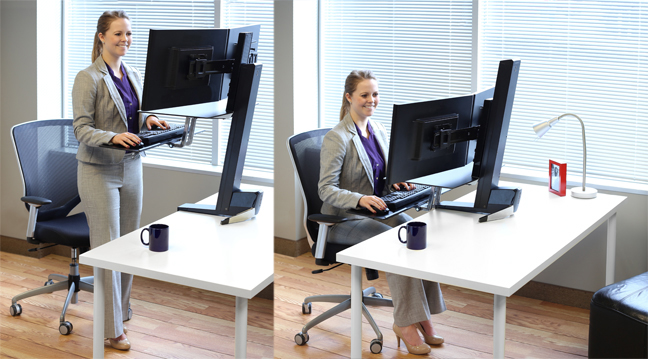Budget is often a perceived barrier to widescale adoption of sit-stand workstations. While the promise of savings is strong, when you consider the overwhelming cost of inactivity to physical and mental health, the direct correlation has never been fully investigated.
To address the gap, an Australian research team designed a study with the purpose of determining whether sit-stand desks are a cost-effective alternative to ordinary office environments where people are sedentary most of the work day. The study, which was published in August by the Scandinavian Journal of Work and Occupational Health, calculated both short- and long-term cost benefits of sit-stand desks.
“It is the first study to report both the within-trial cost-efficacy and long-term cost-effectiveness of an intervention incorporating a sit-stand workstation targeting desk-based workers.”
– Authors of the study
The Ergotron WorkFit™-S Dual Workstation with Worksurface was selected as the intervention. With it, participants could easily and quietly alternate their working posture between sitting and standing without constraint. Researchers noted that the keyboard and monitor moving in tandem helped ensure that the appropriate ergonomic posture was maintained throughout the study, and that overall, the desk converter required minimal desk space.

The Results
The study found the intervention to be cost-effective. What’s more, researchers found that the benefits of a 12-month intervention would positively impact the long-term health and longevity of users.
When modestly scaled up to the national workforce, the intervention had a 100% chance of being cost-effective, leading to more life years (LY) and health-related quality of life gains (HALY), and lower long-term health costs. The announcement of the results coincides with the recent World Health Organization (WHO) action plan to reduce physical inactivity. A key part of the WHO plan is to create active systems, and this research provides important evidence for policy makers and workplaces regarding allocation of resources to reduce workplace sitting.
Reacting to the news, Ergotron’s research manager Carrie Schmitz commented, “This much-anticipated study demonstrates that reducing sitting and increasing movement in the workplace are powerful and cost-effective strategies in both the short and long term. Since office workers face similar health risk factors globally due to sedentary behavior, these calculations are not limited to the Australian population.”
Cost implications were considered holistically, both to the government as a third-party provider of healthcare services in Australia and the costs to private organizations implementing the program within their workplaces. The cost of the intervention included the WorkFit-S Dual, set-up, training, monitoring and even adverse outcomes. They then factored-in cost offsets associated with disease prevention of nine diseases related to obesity, provided by the Australian National Health Service.
Businesses on the fence about sit-stand computing for their employee base will find the research compelling and further evidence that a well-designed sit-stand desk is not just an ergonomic investment. Try our WorkFit Payback Calculator to see how quickly it can pay for itself.
“In addition, the long-term model does not account for productivity gains in the absence of a disease, which means that the societal savings from the intervention are likely to be substantially underestimated.”
– Authors of the study
About the trial and cost analysis
The trial, Stand Up Victoria, was conducted in 14 worksites within the same organization between 2012–2014. There were 231 total participants in the trial divided between 136 using the sit-stand intervention and 95 using ordinary, sit-only desks. The investigators extrapolated up from the original study group to a national population, based on the assumption that of the 45% of Australian citizens who have sedentary jobs, one-fifth might obtain a sit-stand desk through their employer.
Both the short- and long-term analyses adopted a societal perspective, which took into account costs to government as a third-party provider of healthcare services in Australia and the costs to private organizations implementing the program within their workplaces. All costs were reported in 2014 Australian dollars (1 AU$ = 0.943 US$ June 2014) and analyses were performed on an intention-to-treat (ITT) basis.



